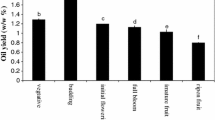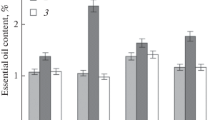Abstract
A study was made of the changes in the content of essential oil and its components (farnesene, (-)-α-bisabolol, (-)-α-bisabololoxide A, (-)-α-bisabololoxide B and spathulenol, α-bisabolonoxide A, chamazulene, cis en-in-dicycloether) and of the number of secretory canals in the receptacles during the beginning of flowering, full flowering and the termination of flowering of camomile anthodia. The total content of the essential oil was highest during the beginning of flowering and lowest during its termination. The proportion of the individual sesquiterpenes in the essential oil underwent changes mostly during the beginning and termination of flowering. The number of secretory canals in the basal and middle anthodial parts increased during the beginning of flowering and the full flowering.
Similar content being viewed by others
References
Bliss, C. J.: [Analysis of field experimental data given in percentages]. In Russ. - Byul. Z a shchity Rast.12: 67–77, 1937.
Felklová, M., Motl, O., Jasičová, M., Lukeš, V.: [Proportion of main components in volatile oil ofMatricaria chamomilla L. in the course of its flowering period]. In Czech. -českoslov. Farmac.27: 322–325, 1978.
Franz, Ch.: Content and composition of the essential oil in flower heads ofMatricaria chamomilla L. during its ontogenetical development. - Planta med.36: 282–283, 1979.
Glücknerová, E., Blazek, Z.: [Localization of the main effective substances inFlos Ohamomillae vulgaris.] In Czech. - Farmac. Obzor34: 148–154, 1965.
Glücknerová, E., Blazer, Z., Starý, F.: [Characteristics of Czechoslovak recognized varieties ofMatricaria chamomilla L.] In Czech.- Českoslov. Farmac14: 105–112, 1965.
Goodwin, T. W.: The biological significance of terpenes in plants. - In:Pridham, J. B. (ed.): Terpenoids in Plants. Pp. 1–23. Academic Press, London-New York 1967.
Gross, D.: Growth regulatory substances of plant origin. - Phytochemistry14: 2105–2112, 1975.
Herout, V.: Biochemistry of sesquiterpenoids. - In:Goodwin, T. W. (ed.): Aspects of Terpenoid Chemistry and Biochemistry. Pp. 53–94. Academic Press, London-New York 1971.
Hölzl, J., Demuth, G.: Einfluss ökologischer Faktoren auf die Bildung des ätherischen Öls der Flavone verschiedene Kamillenherkünfte. 1. Kritischer Vergleich der quantitativen Bestimmungsmethoden. - Planta med.27: 37–45, 1975.
Hölzl, J., Franz, G., Fritz, D., Vömel, A.: Untersuchungen über die Bildung des ätherischen Öls vonMatricaria chamomilla L. 1.14C-Markierung der ätherischen Ölbestandteile. - Z. Naturforsch.30 C: 853–854, 1975.
Janko, J.: Statistické Tabulky. [Statistical Tables.] - Praha 1958.
Kaiser, H., Hasenmaier, G.: Untersuchungen über die Azulenbildung beiMatricaria chamomilla L. -Arch. Pharm. (Weinheim)289: 681–695, 1956.
Lassänyi, Z., Stieber, G., Tyihák, E.: [Investigation of the volatile oil secretory system ofChamomillae Anthodium (Flos) I. Histochemieal analysis of glandular hairs.] In Hung. - Herba hung.17 (2): 31–42, 1978.
Motl, O., Repčák, M., Sedmera, P.: Weitere Bestandteile des Kamillenöls, 2. Mitt. - Arch. Pharm. (Weinheim)311: 75–76, 1978.
Němec, B. et al.: Botanická mikrotechnika. [Botanical Microtechnic] In Czech. - Nakl. ČSAV, Praha 1962.
Plokhinskiï, N. A.: Biometriya. [Biometry]. In Russ. - Moskva 1970.
Ruminska, A.: Der Einfluss des Entwicklungsstadium auf die chemische Zusammensetzung (einschliesslich einiger morphologischer Merkmale der Blütenkorbchen) vonAchillea millefolium L. undMatricaria chamomilla L. - Wiss. Z. K.-Marx-Univ., Math. - Natur. Wiss. (Leipzig)2: 429–433, 1965.
Schantz, M. v., Salonen, R.: Untersuchungen über den Ölgehalt und die Gesamtazulenmenge während der Entwicklung der Blütenkorbchen von in Finnland wildwachsender Kamille (Matricaria chamomilla L.) - Sci. Pharm.34: 177–185, 1966.
Schenck, G., Frömming, K. H.: Öl- und Azulengehalt vonMatricaria chamomilla in verschiedenen Blähstadien. - Arch. Pharm. (Weinheim)289: 200–203, 1956.
Štěrba, B.: [Reconnaissance of essential oil content ofMatricaria chamomilla L. during its growth]. In Czech. -Čas. čes. Lékárnictva62 (Suppl.): 1–11, 1949.
Stieber, G., Lassányi, Z., Tyihák, E.: [Investigation of the volatile oil secreting system ofChamomillae Anthodium (Flos) II. Changes in prochamazulene content of glandular hair in camomile flower during ontogeny.] In Hung. -Herba hung.18 (1): 27–39, 1979.
Vágújfalvi, D., Tyihák, E.: [Diurnal changes of prochamazulene content ofMatricaria chamomilla L.] In Hung. - Bot. Közl.49: 64–70, 1961.
Author information
Authors and Affiliations
Rights and permissions
About this article
Cite this article
Repčák, M., Halásová, J., Hončariv, R. et al. The content and composition of the essential oil in the course of Anthodium development in wild camomile (Matricaria chamomilla L.). Biol Plant 22, 183–191 (1980). https://doi.org/10.1007/BF02892736
Received:
Accepted:
Issue Date:
DOI: https://doi.org/10.1007/BF02892736




